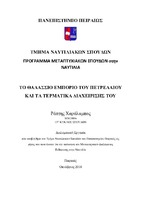Το θαλάσσιο εμπόριο του πετρελαίου και τα τερματικά διαχείρισής του

Προβολή/
Λέξεις κλειδιά
Πετρέλαιο ; Αργό πετρέλαιο ; Πετρελαιοειδή ; Θαλάσσιες μεταφορές ; Δεξαμενόπλοια ; Τερματικά διαχείρισης πετρελαίου ; ΛιμάνιαΠερίληψη
Το πετρέλαιο σαν η κύρια πηγή ενέργειας το τελευταίο αιώνα συνέβαλε τα μέγιστα στη διαμόρφωση του κόσμου όπως είναι σήμερα με τα θετικά και τα αρνητικά του. Το θαλάσσιο εμπόριο αποτελεί τη πιο φθηνή, αξιόπιστη και ενίοτε μοναδική μέθοδο μεταφοράς μεγάλων ποσοτήτων πετρελαίου ανά το κόσμο.Η αγορά του πετρελαίου διαμορφώνεται από τις δυνάμεις της προσφοράς (παραγωγής) και της ζήτησης (κατανάλωσης), η ανάλυση των οποίων δημιουργεί το χάρτη του θαλασσίου εμπορίου.Η κατανομή των πόρων είναι άνιση , καθώς περιοχές όπως η Μέση Ανατολή και η Βόρεια Αμερική κατέχουν πάνω από τη μισή παγκόσμια παραγωγή. Ενώ η ζήτηση επικεντρώνεται στην Άπω Ανατολή, Βόρεια Αμερική και Ευρώπη. Τα μεγέθη των δεξαμενόπλοιων ποικίλουν ανάλογα το τύπο του πετρελαίου που μεταφέρουν και τα λιμάνια που προσεγγίζουν. Τα πλοία μεταφοράς αργού πετρελαίου είναι μεγαλύτερου μεγέθους από τα πιο εξειδικευμένα πλοία προϊόντων του πετρελαίου. Στα πλαίσια της κατεύθυνσης του IMO προς τις ασφαλείς και «πράσινες» μεταφορές, τα τερματικά οφείλουν να εκσυγχρονίζονται με σύγχρονα συστήματα, πρακτικές και κανονισμούς. Τον 21ο αιώνα ο χάρτης των μεγαλύτερων λιμανιών διαχείρισης πετρελαίου στο κόσμο άλλαξε ριζικά με την ανάπτυξη των λιμένων της Κίνας. Το Ρότερνταμ κατείχε για 42 συναπτά έτη τη πρωτοκαθεδρία σε όρους διακίνησης φορτίων εισαγωγής πετρελαίου στο κόσμο. Πλέον εξαγωγικά λιμάνια όπως το Al Juaymah της Σαουδικής Αραβίας, και εισαγωγικά όπως το Ningbo της Κίνας αλλά και το LOOP των ΗΠΑ αποτελούν τα κομβικότερα σημεία από πλευράς διακίνησης φορτίου και ευχέρειας προσόρμησης πλοίων μεγάλου βυθίσματος.

